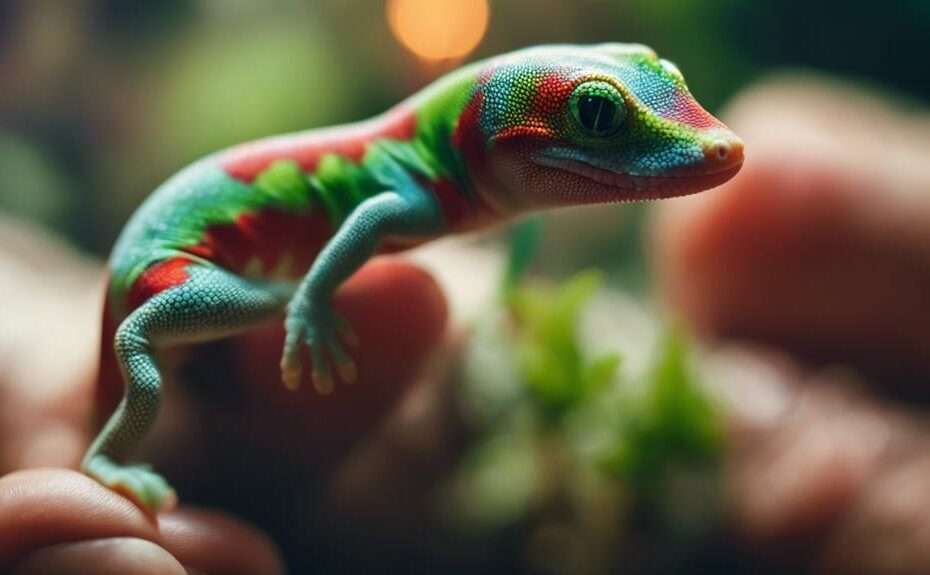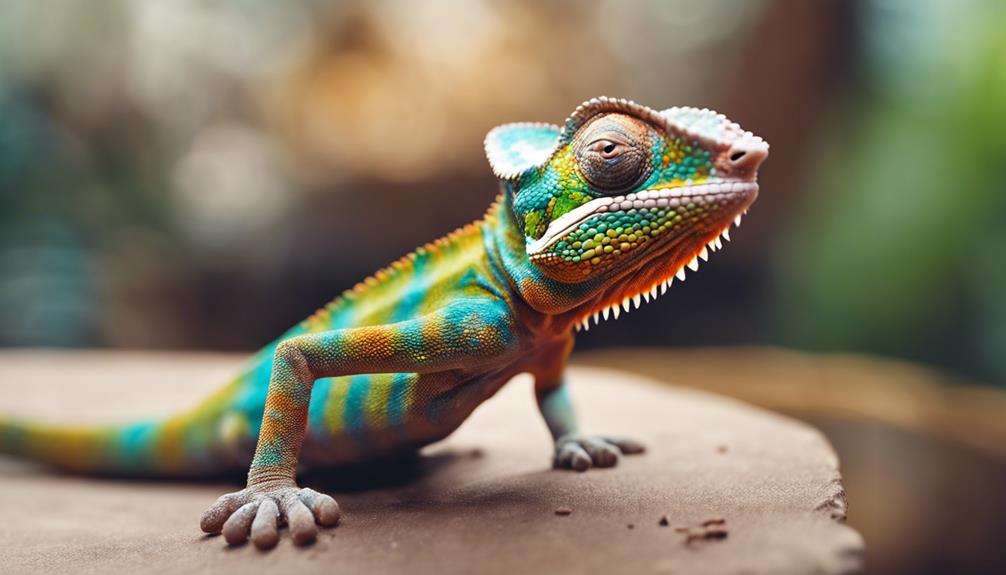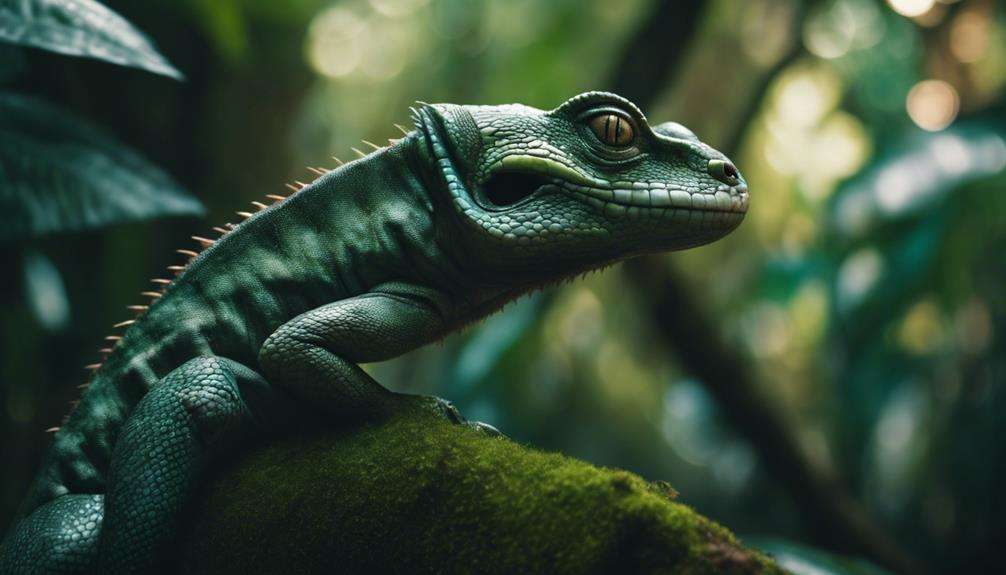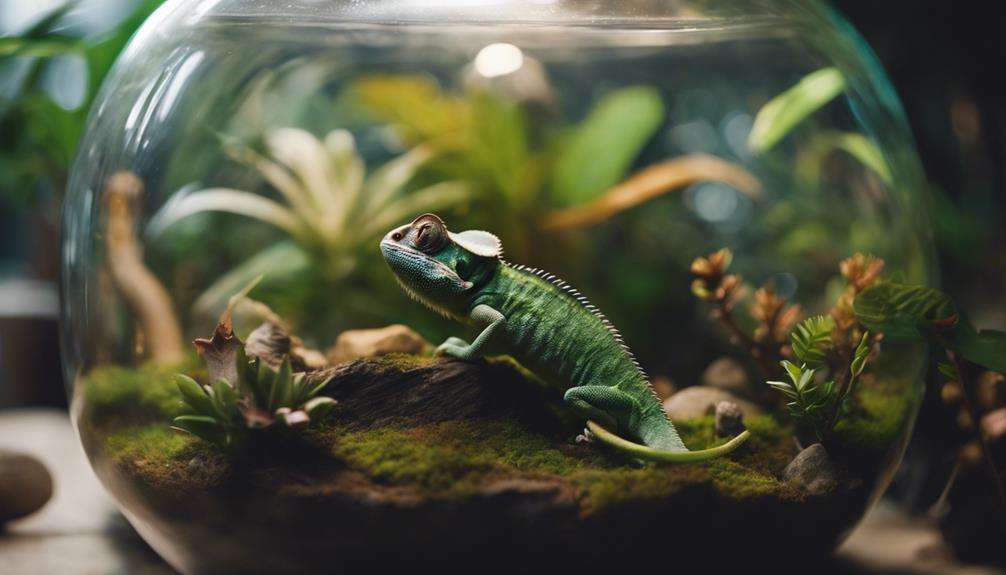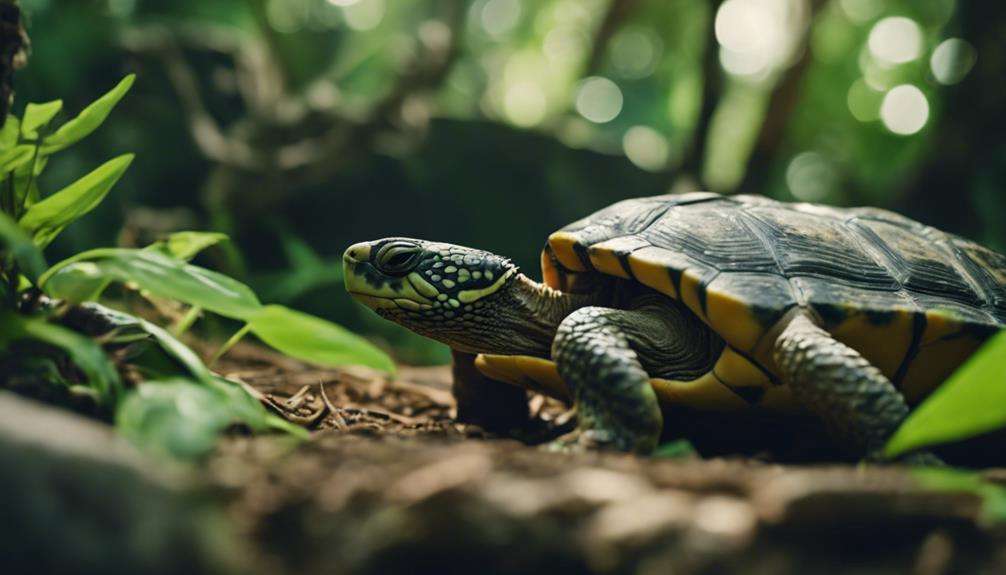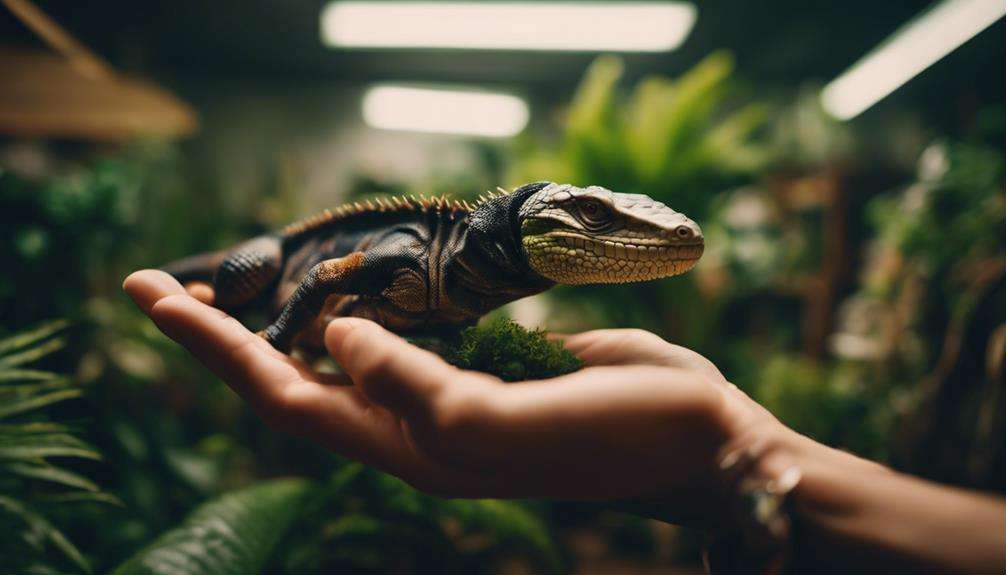If you think rare reptiles are too tricky for kids, think again. There are some fascinating options out there that could surprise you.
From vibrant Crested Geckos to the charming Leopard Geckos, these creatures offer more than meets the eye.
Curious to find out which other unique reptiles could be perfect companions for your little one? Keep on exploring to uncover some unexpected gems that might just be the ideal fit for your family.
Key Takeaways
- Crested geckos and leopard geckos are ideal for kids due to calm temperaments and manageable care.
- Blue-tongued skinks and Russian tortoises offer children interactive experiences with unique appearances.
- Reptile ownership educates children on responsibility, ecosystems, animal behavior, and fosters a connection to nature.
- Proper care, diet, and environment ensure fulfilling lives for rare reptiles as pets and valuable learning experiences for children.
Crested Gecko
The Crested Gecko, known for its calm temperament and interactive nature, is an ideal reptile pet for children due to its easy care requirements and friendly demeanor. These geckos, with their loving nature, offer children interactive experiences as they're fond of climbing and exploring their environment.
Their diet consisting of bugs, crickets, and specialized gecko food is simple to manage, making it convenient for young caretakers. As Crested Geckos mature, they become even more amiable, allowing for long-term companionship with children.
Apart from their docile nature, these geckos exhibit a unique appearance with crests that run from their eyes to their tail, adding to their appeal as pets. Due to these qualities, Crested Geckos have become a popular choice for families with kids seeking a low-maintenance yet engaging reptile companion.
Leopard Gecko
Leopard Geckos, scientifically known as Eublepharis macularius, make fascinating pets for children due to their manageable size and calm demeanor. These nocturnal creatures are primarily active during the night, showcasing interesting behaviors such as tail waving and the ability to detach their tails in defense.
When caring for a Leopard Gecko, it's crucial to provide a varied diet that includes live insects like crickets and mealworms, supplemented with calcium to maintain their health and well-being.
Leopard Gecko Care
When caring for a leopard gecko, it's essential to provide the proper environment and nutrition to ensure their health and well-being. These small reptiles can live for 8-10 years in captivity and are typically housed in glass tanks with rocks and a water dish for hydration.
Leopard geckos require a heat bulb and UV-A/UV-B light for proper calcium absorption, crucial for their well-being. Their diet should consist of live crickets, mealworms, and calcium-dusted insects to meet their nutritional needs adequately.
Recognizable by their yellow skin with spots, leopard geckos are known for their docile nature, making them great pets for children. By ensuring they've the right habitat, lighting, and diet, you can enjoy the company of these fascinating reptiles for years to come.
Leopard Gecko Behavior
For a deeper understanding of leopard gecko behavior, observe their docile and gentle interactions with humans, their crepuscular activity patterns, unique vocalizations, solitary nature, and their fascinating ability to regenerate dropped tails. Leopard geckos:
- Demonstrate docile and gentle behavior towards humans.
- Are most active during dawn and dusk due to their crepuscular nature.
- Communicate using unique vocalizations like chirping and barking.
- Are solitary animals and should be housed separately except for breeding purposes.
These fascinating reptiles exhibit intriguing behaviors that make them a unique and interesting pet choice, from their gentle demeanor to their distinctive ways of communication and regeneration abilities.
Leopard Gecko Diet
To ensure optimal nutrition and health for your leopard gecko, it's crucial to provide a varied diet consisting primarily of live insects such as crickets, mealworms, and calcium-dusted options. Leopard geckos, being insectivores, require this diet to thrive.
Supplement their meals with gut-loaded insects and offer occasional treats like waxworms or silk worms to provide enrichment and a varied nutrient profile. Adult leopard geckos should be fed every 2-3 days to maintain a healthy weight and digestive system.
Remember to provide a balanced diet with appropriate calcium and vitamin supplements to support your leopard gecko's overall health and well-being. Proper nutrition is key to ensuring your pet's longevity and vitality.
Blue-Tongued Skinks
Blue-Tongued Skinks, recognized for their striking blue tongues, are renowned as large-bodied reptiles with a friendly demeanor, making them ideal companions for children under supervision. These fascinating creatures exhibit a calm and gentle nature, which is perfect for introducing children to responsible pet ownership.
Here are some key points to consider when caring for Blue-Tongued Skinks:
- Enclosure: Ensure they've a spacious terrarium with proper heating and lighting to mimic their natural habitat.
- Diet: Blue-Tongued Skinks are omnivorous, enjoying a varied diet that includes insects, fruits, and leafy greens. Providing a balanced diet is crucial for their health and well-being.
- Lifespan: With the right care, these skinks can live for 15-20 years in captivity, offering a long-term opportunity for children to learn and bond with their pet.
- Interaction: Supervised interaction between children and Blue-Tongued Skinks can foster a sense of responsibility and respect for these amazing reptiles.
Russian Tortoise
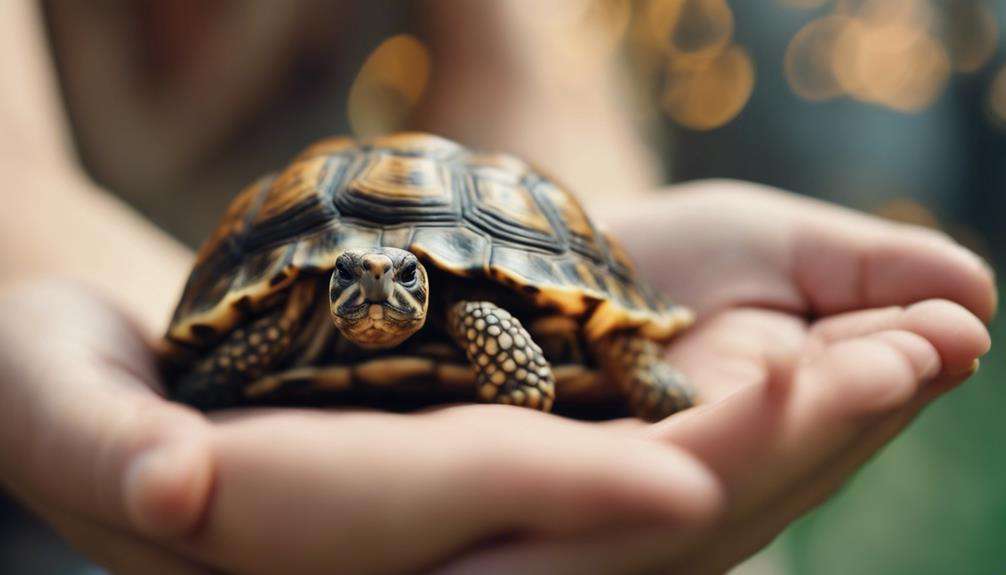
Active and inquisitive, the Russian Tortoise is a captivating reptile species that can grow up to 10 inches in size. With proper care, these tortoises have the potential to live over 40 years in captivity. When considering a Russian tortoise as a pet for your child, it's essential to provide adequate housing. They thrive in warm climates or well-ventilated tanks that mimic their natural habitat. Ensuring a deep substrate, along with heat bulbs and UVB lighting, is crucial for their health and well-being.
In terms of diet, Russian tortoises should be offered a variety of dark leafy greens, vegetables, and occasional fruit treats. It's important to research and understand their dietary needs to maintain their health. By creating a suitable environment and offering a balanced diet, you can provide a fulfilling life for your Russian tortoise as a unique and educational pet for your child.
Box Turtle
The Box Turtle, known for its long lifespan of up to 100 years in captivity, exhibits a unique shell retracting ability for protection and has specific housing and dietary requirements. These reptiles can make great pets for families seeking a long-term companion that requires minimal upkeep.
- Shell Retracting Ability: Box turtles have the remarkable capability to retract their head, legs, and tail into their shell when they feel threatened, providing them with a protective shield against predators.
- Specific Housing Needs: To thrive, box turtles need an enclosure that includes both a land area for basking and digging, as well as a shallow water area for soaking and drinking.
- Varied Diet: Their diet should consist of a variety of foods including dark leafy greens, insects like crickets and worms, and fruits to ensure they receive a balanced nutritional intake.
- Long-Term Companion: Given their potential century-long lifespan, box turtles can be a lasting and rewarding pet for families willing to commit to their care and well-being.
Chameleon
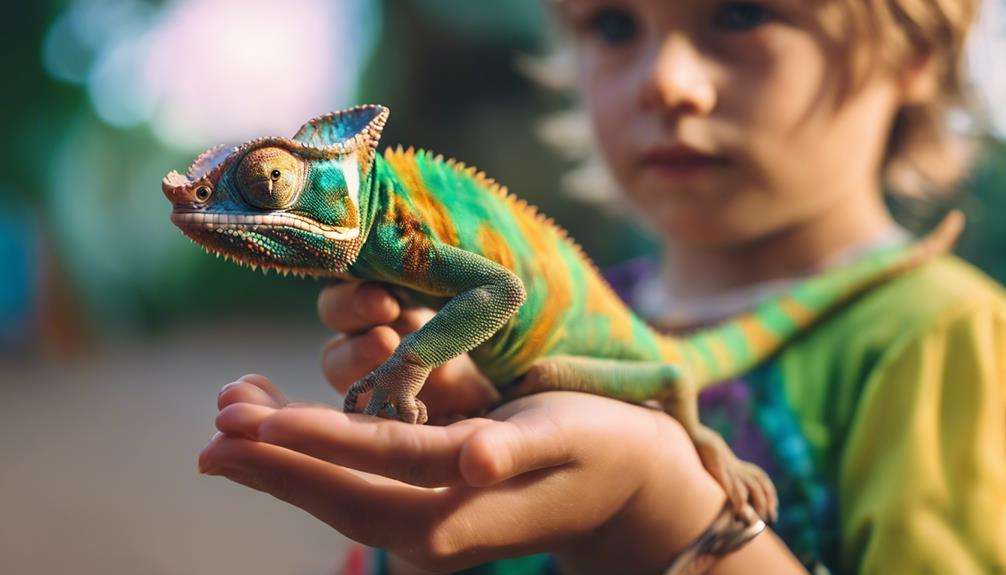
Chameleons are fascinating reptiles known for their remarkable color-changing abilities, allowing them to camouflage effectively in their surroundings. These creatures possess specialized feet for climbing and eyes that can move independently, aiding in their hunting strategies.
To ensure the well-being of a chameleon pet, it's crucial to maintain specific humidity levels, provide suitable temperatures, and offer a diet rich in insects and occasional fruits.
Chameleon Care Tips
For optimal well-being, providing a specialized setup with proper UVB lighting and humidity levels is crucial when caring for a chameleon. These reptiles have unique characteristics, such as the ability to change colors based on mood, temperature, and environment. To ensure the well-being of your chameleon, consider the following care tips:
- UVB Lighting: Install a UVB light in the enclosure to aid in calcium absorption and overall health.
- Humidity Levels: Maintain humidity levels between 50-70% to support proper hydration and shedding.
- Minimal Handling: Limit handling to reduce stress, as chameleons are delicate creatures.
- Veterinary Check-ups: Regularly schedule veterinary visits to monitor your chameleon's health and well-being.
Chameleon Diet Requirements
To properly nourish your chameleon, it's vital to understand and meet their specific dietary requirements for optimal health and well-being. Chameleons thrive on a diet of live insects such as crickets, roaches, and mealworms. Ensuring these insects are gut-loaded with nutritious food before feeding them to your chameleon is crucial for their overall health.
Additionally, chameleons benefit from the supplementation of calcium and vitamins on their prey to ensure they receive essential nutrients. Offering a variety of insects in their diet is important to meet their nutritional needs adequately. Hydration is also key; misting their enclosure regularly and providing water droplets for them to drink from helps maintain their well-being.
Chameleon Habitat Setup
Understanding the importance of creating a suitable habitat for your chameleon is crucial for promoting their well-being and ensuring their natural behaviors can be expressed effectively. When setting up your chameleon's enclosure, consider the following:
- Enclosure: Provide a tall enclosure with ample space for climbing and exploring.
- Branches and Foliage: Include plenty of branches and foliage to mimic their natural habitat.
- UVB Lighting: Install UVB lighting to aid in calcium metabolism and overall health.
- Humidity Levels: Maintain humidity levels between 50-70% for proper hydration and shedding.
Frequently Asked Questions
What Is the Most Kid Friendly Reptile?
When considering reptiles for kids, the Leopard Gecko stands out as an ideal choice. With its gentle demeanor, vibrant colors, and easy care requirements, it's a great introduction to the world of reptile pets.
What Is the Easiest Reptile to Take Care of for a Kid?
For a kid, the easiest reptile to care for is a Leopard Gecko. They are low maintenance, live 15-20 years, need a dry habitat, eat insects, and come in various colors. With proper care, they make great pets.
What Is the Friendliest Reptile Pet?
For a friendly reptile pet, the Crested Gecko stands out with its calm demeanor and fun climbing antics. When seeking a cuddly companion, the Leopard Gecko or the Russian Tortoise are excellent choices for kids.
What Are Uncommon Reptiles to Own?
When seeking uncommon reptiles, consider exotic geckos, unusual skinks, rare tortoises, lesser known snakes, unique chameleons, odd lizards, uncommon frogs, exotic turtles, rarely seen newts, and lesser known salamanders. These fascinating creatures offer diverse options for reptile enthusiasts.
Conclusion
In conclusion, when considering rare reptiles as pets for children, the Crested Gecko, Leopard Gecko, Blue-Tongued Skinks, Russian Tortoise, Box Turtle, and Chameleon are all excellent choices.
These fascinating creatures offer a unique opportunity for educational engagement and interactive care, while also providing a sense of wonder and excitement for young minds to explore.
Embrace the joy of caring for these special reptiles and watch as your child's curiosity and love for nature blossoms.
